The Villa Ludovisi was a suburban villa in Rome, built in the 17th century on the area once occupied by the Gardens of Sallust (Horti Sallustiani) near the Porta Salaria. [1] On an assemblage of vineyards purchased from Giovanni Antonio Orsini, Cardinal Francesco Maria Del Monte and others, Cardinal Ludovico Ludovisi erected in the 1620s the main villa building to designs by Domenichino; it was completed within thirty months, in part to house his collection of Roman antiquities, [2] additions to which were unearthed during construction at the site, which had figured among the great patrician pleasure grounds of Roman times. Modern works, most famously Gian Lorenzo Bernini's Pluto and Persephone , were also represented. The engraving of the grounds by Giovanni Battista Falda (1683) [3] shows a short access avenue from a tree-lined exedra in via di Porta Pinciana and cypress-lined avenues centered on each of the facades of the main villa, laid out through open fields, the main approaches to both the villa and the Casino dell'Aurora [4] converging on gates in the Aurelian Walls, which formed the northern bounds of the park; symmetrical parterres of conventional form including bosquets peopled with statuary [5] flanked the main avenue of the Casina, and there was an isolated sunken parterre, though these features were not integrated in a unified overall plan. [6] The overgrown avenues contrasting with the dramatic Roman walls inspired Stendhal to declare in 1828 that the Villa Ludovisi's gardens were among the most beautiful in the world. [7]
Frescoes in the villa were carried out by Domenichino, Guercino, Giovambattista Viola, and others. A casina was added, largely to house the Cardinal's growing collection of Roman sculptures and inscriptions, which Alessandro Algardi treated to sometimes extensive restoration.
The villa passed to the ownership of the Boncompagni Ludovisi family, which in 1872 rented it to King Victor Emmanuel II. The King used the villa as residence for his lover, Rosa Vercellana. [8]
İn 1885, despite great protests among the intellectuals, its last owner, Don Rodolfo Boncompagni Ludovisi, the Prince of Piombino, faced serious financial troubles and decided to sell the property to the Società Generale Immobiliare. The Villa was divided into building lots. [9] The sculptures [10] were dispersed, and most of the buildings destroyed, the only one to remain being the Casino dell'Aurora. [11]
The Via Veneto was driven through the former grounds, part of which are occupied by the American Embassy in Palazzo Margherita, and the Rione Ludovisi took shape, borrowing its name from the cardinal and his villa.
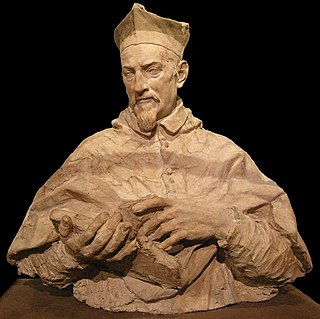
Alessandro Algardi was an Italian high-Baroque sculptor active almost exclusively in Rome, where for the latter decades of his life, he was, along with Francesco Borromini and Pietro da Cortona, one of the major rivals of Gian Lorenzo Bernini. He is now most admired for his portrait busts that have great vivacity and dignity.

The Galleria Borghese is an art gallery in Rome, Italy, housed in the former Villa Borghese Pinciana. At the outset, the gallery building was integrated with its gardens, but nowadays the Villa Borghese gardens are considered a separate tourist attraction. The Galleria Borghese houses a substantial part of the Borghese Collection of paintings, sculpture and antiquities, begun by Cardinal Scipione Borghese, the nephew of Pope Paul V. The building was constructed by the architect Flaminio Ponzio, developing sketches by Scipione Borghese himself, who used it as a villa suburbana, a country villa at the edge of Rome.

Ludovisi is the 16th rione of Rome (Italy), identified by the initials R. XVI and located within the Municipio I.

Sallustiano is the 17th rione of Rome, identified by the initials R. XVII. It is located within the Municipio I and the name refers to the ancient Gardens of Sallust, which were located here.

The Ludovisi Ares is an Antonine Roman marble sculpture of Mars, a fine 2nd-century copy of a late 4th-century BCE Greek original, associated with Scopas or Lysippus: thus the Roman god of war receives his Greek name, Ares.

Jupiter, Neptune and Pluto is a painting by Italian Baroque master Michelangelo Merisi da Caravaggio. It is located in the Villa Aurora, the former hunting lodge of the erstwhile Villa Ludovisi, Rome. It is unusually painted in oils on plaster and hence it is not a fresco, although it is sometimes (incorrectly) referred to as such. Oil painting is normally on canvas or, less frequently, on wood.

The Villa Doria Pamphili is a seventeenth-century villa with what is today the largest landscaped public park in Rome, Italy. It is located in the quarter of Monteverde, on the Gianicolo, just outside the Porta San Pancrazio in the ancient walls of Rome where the ancient road of the Via Aurelia commences.

The Casino di Villa Boncompagni Ludovisi is a historical building in Rione Ludovisi, Rome, Italy.

The Gardens of Sallust was an ancient Roman estate including a landscaped pleasure garden developed by the historian Sallust in the 1st century BC. It occupied a large area in the northeastern sector of Rome, in what would become Region VI, between the Pincian and Quirinal hills, near the Via Salaria and later Porta Salaria. The modern rione is now known as Sallustiano.
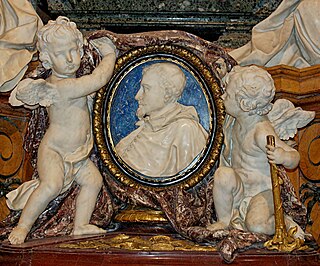
Ludovico Ludovisi was an Italian cardinal and statesman of the Roman Catholic Church. He was an art connoisseur who formed a famous collection of antiquities, housed at the Villa Ludovisi in Rome.

The Palazzo Pallavicini-Rospigliosi is a palace in Rome, Italy. It was built by the Borghese family on the Quirinal Hill; its footprint occupies the site where the ruins of the baths of Constantine stood, whose remains still are part of the basement of the main building, the Casino dell'Aurora. Its first inhabitant was the famed art collector Cardinal Scipione Borghese, the nephew of Pope Paul V, who wanted to be housed near the large papal Palazzo Quirinale. The palace and garden of the Pallavicini-Rospigliosi were the product of the accumulated sites and were designed by Giovanni Vasanzio and Carlo Maderno in 1611–16. Scipione owned this site for less than a decade, 1610–16, and commissioned the construction and decoration of the casino and pergolata, facing the garden of Montecavallo. The Roman palace of this name should not be mistaken for the panoramic Villa Pallavicino on the shores of Lake Como in Lombardy.

The National Roman Museum is a museum, with several branches in separate buildings throughout the city of Rome, Italy. It shows exhibits from the pre- and early history of Rome, with a focus on archaeological findings from the period of Ancient Rome.

The Villa Aldobrandini is a villa in Frascati, Italy. It is still owned and lived in by the Aldobrandini family, and known as Belvedere for its location overlooking the valley toward the city of Rome.
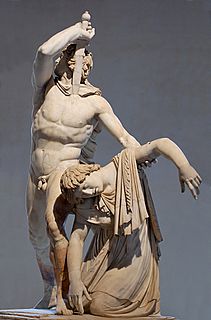
The Ludovisi Gaul Killing Himself and His Wife is a Roman marble group depicting a Gallic man in the act of plunging a sword into his breast, looking backwards defiantly while he supports the dying figure of a woman with his left arm. It is a Roman copy of the early 2nd century AD, of a Hellenistic original, ca 230-20 BC, one of the bronze groups commissioned from Greek sculptors by Attalus I after his recent victories over the Gauls of Galatia. Other Roman marble copies from the same project are the equally famous Dying Gaul, and the less well-known Kneeling Gaul.
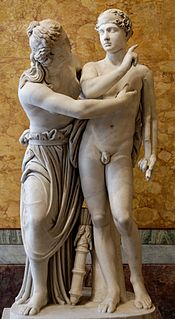
Ippolito Buzzi (1562–1634) was an Italian sculptor from Viggiù, near Varese, in northernmost Lombardy, a member of a long-established dynasty of painters, sculptors and architects from the town, who passed his mature career in Rome. His personality as a sculptor is somewhat overshadowed by the two kinds of work he is known for: restorations to ancient Roman sculptures, some of them highly improvisatory by modern standards, and sculpture contributed to architectural projects and funeral monuments, where he was one among a team of craftsmen working under the general direction of an architect, like Giacomo della Porta - in projects for Pope Clement VIII, or Flaminio Ponzio - in projects for Pope Paul V - who would provide the designs from which the work was executed, always in consultation with the patron.
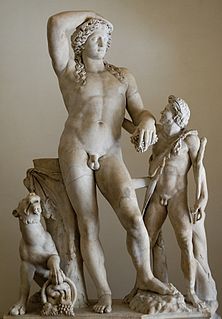
The over-lifesize marble Dionysus with Panther and Satyr in the Palazzo Altemps, Rome, is a Roman work of the 2nd century AD, found in the 16th century on the Quirinal Hill at the time foundations were being dug for Palazzo Mattei at Quattro Fontane. The statue was purchased for the Ludovisi collection, where it was first displayed in front of the Palazzo Grande, the main structure of the Villa Ludovisi, and by 1641 in the gallery of sculptures in the Casino Capponi erected for Cardinal Ludovico Ludovisi in the villa's extensive grounds. By 1885, it had been removed to the new Palazzo del Principe di Piombino, nearby in via Veneto. With the rest of the Boncompagni-Ludovisi collection, which was open to the public on Sundays and covered in the guidebooks, and where it had become famous, it was purchased in 1901 for the City of Rome, as the Ludovisi collection was dispersed and the Villa's ground built over at the end of the 19th century.

Palazzo Margherita, formerly Palazzo Piombino, is a palazzo on Via Veneto in Rome. The usual name references Queen Margherita of Savoy, who lived there from 1900 to 1926. It now contains a U.S. embassy.
Boncompagni is a noble Italian family.



















